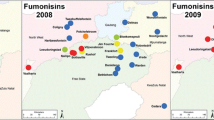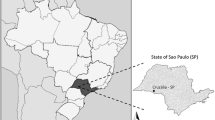Abstract
Field experiments in the high rainfall zone (HRZ) and the medium rainfall zone (MRZ) in Zambia were designed to determine the natural occurrence of fumonisins (FB1–2) in Zambian maize hybrids, accumulation of FB1–2 resulting from artificial inoculation with Fusarium verticillioides and effects of climate and planting time on FB1–2 in maize. Combined FB1–2 concentrations varied from 0 to 13,050 ng/g, with an overall mean of 666 ng/g. Maize from the HRZ had low incidences of FB1–2-positive samples (mean 41%) which contained FB1–2 below 500 ng/g. In the MRZ, higher incidences (mean 97%) and concentrations (40% of samples >1,000 ng/g) were recorded in two out of three years. There was no correlation between mean location FB1–2 concentrations in individual years and precipitation, number of rain days or monthly precipitation. Postponing the planting time with 10 or 20 days did not significantly affect FB1–2 concentration, but it reduced the yields in some years.
Similar content being viewed by others
References
Miller JD. Epidemiology of Fusarium ear diseases of cereals. In: Miller JD, Trenholm HL, editors. Mycotoxins in Grain: compounds other than aflatoxin. St. Paul, Minnesota, USA: Eagan Press; 1994. p. 19–36.
Logan J. Diseases of maize. Farming Zambia. 1974;8:15–27.
Marasas WFO, Kriek NPJ, Fincham JE, Van Rensburg SJ. Primary liver cancer and oesophageal basal cell hyperplasia in rats caused by Fusarium moniliforme. Int J Cancer. 1984;34:383–7. doi:10.1002/ijc.2910340315.
Gelderblom WCA, Jaskiewicz K, Marasas WHO, Thiel PG, Horak RM, Vleggaar R, et al. Fumonisins-novel mycotoxins with cancer-promoting activity produced by Fusarium moniliforme. Appl Environ Microbiol. 1988;54:806–1811.
Ross PF, Rice LG, Osweiler GD, Nelson PE, Richard JL, Wilson TM. A review and update of animal toxicoses associated with fumonisin-contaminated feeds and production. Mycopathologia. 1992;117:109–14. doi:10.1007/BF00497286.
Sydenham EW, Thiel PG, Marasas WFO, Shephard GS, Van Schalkwyk DJ, Koch KR. Natural occurrence of some Fusarium mycotoxins in corn from low and high esophageal cancer prevalence areas of the Transkei, Southern Africa. J Agric Food Chem. 1990;38:1900–3. doi:10.1021/jf00100a004.
Chu FS, Li GY. Simultaneous occurrence of fumonisin B1 and other mycotoxins in moldy corn collected from the People’s Republic of China in regions with high incidences of esophageal cancer. Appl Environ Microbiol. 1994;60:847–52.
Stack ME. Analysis of fumonisin B1 and its hydrolysis product in tortillas. J Anal Chem. 1998;81:737–40. 1998.
Gelderblom WCA, Cawood ME, Synman SD, Marasas WFO. Fumonisin B1 dosimetry in relation to cancer initiation in rat liver. Carcinogenesis. 1994;15:209–14. doi:10.1093/carcin/15.2.209.
Osuchowski MF, Edwards GL, Sharma RP. Fumonisin B1-induced neurodegeneration in mice after intracerebroventricular infusion is concurrent with disruption of sphingolipid metabolism and activation of proinflamatory signaling. Neurotoxicology. 2005;26:211–21. doi:10.1016/j.neuro.2004.10.001.
Beardall J, Miller JD. Natural occurrence of mycotoxins other than aflatoxin in Africa, Asia and South America. Mycotox Res. 1994;10:21–40.
Doko MB, Visconti A. Occurrence of fumonisins B1 and B2 in corn and corn-based human foodstuffs in Italy. Food Addit Cont. 1994;11:433–9.
Doko MB, Rapior S, Visconti A, Schjøth JE. Incidence and levels of fumonisin contamination in maize genotypes grown in Europe and Africa. J Agric Food Chem. 1995;43:429–34. doi:10.1021/jf00050a032.
Doko MB, Canet C, Brown N, Sydenham EW, Mpuchane S, Siame BA. Natural co-occurrence of fumonisins and zearalenone in cereals and cereal-based foods from Eastern and Southern Africa. J Agric Food Chem. 1996;44:3240–3. doi:10.1021/jf960257+.
Kedera CJ, Plattner RD, Desjardins AE. Incidence of Fusarium spp. and levels of fumonisin B1 in maize in Western Kenya. Appl Environ Microbiol. 1999;65:41–4.
Rheeder JP, Marasas WHO, Thiel PG, Sydenham EW, Shephard GS, Van Schalkwyk DJ. Fusarium moniliforme and fumonisins in corn in relation to human esophageal cancer in Transkei. Phytopathology. 1992;82:353–7. doi:10.1094/Phyto-82-353.
Rheeder JP, Sydenham EW, Marasas WHO, Thiel PG, Shephard GS, Schlechter M, et al. Fungal infestation and mycotoxin contamination of South African commercial maize harvested in 1989 and 1990. S Afr J Sci. 1995;91:127–31.
Shephard GS, Thiel PG, Stockenström S, Sydenham EW. Worldwide survey of fumonisin contamination of corn and corn-based products. J AOAC Int. 1996;79:671–87.
Thiel PG, Marasas WFO, Sydenham EW, Shephard GS, Gelderblom WCA. The implications of naturally occurring levels of fumonisins in corn for human and animal health. Mycopathologia. 1992;117:3–9. doi:10.1007/BF00497272. 1992.
Munkvold GP, Desjardins AE. Fumonisins in maize: can we reduce their occurrence? Plant Dis. 1997;81:556–65. doi:10.1094/PDIS.1997.81.6.556.
Pascale M, Visconti A, Pronczuk M, Wisniewska H, Chelkowski J. Accumulation of fumonisins in maize hybrids inoculated under field conditions with Fusarium moniliforme Sheldon. J Sci Food Agric. 1997;74:1–6. doi:10.1002/(SICI)1097-0010(199705)74:1<1::AID-JSFA752>3.0.CO;2-5.
Rice LG, Ross PF. Methods for detection and quantitation of fumonisins in corn, cereal products and animal excreta. J Food Prot. 1994;57:536–40.
Afolabi CG, Ojiambo PS, Ekpo EJA, Menkir A, Bandyopadhyay R. Evaluation of maize inbred lines for resistance to Fusarium ear rot and fumonisin accumulation in grain in tropical Africa. Plant Dis. 2007;91:279–86. doi:10.1094/PDIS-91-3-0279.
Chulze SN, Ramirez ML, Farnochi MC, Pascale M, Visconti A, March G. Fusarium and fumonisin occurrence in Argentinean corn at different ear maturity stages. J Agric Food Chem. 1996;44:2797–2801. doi:10.1021/jf950381d.
Mumba NE. National research action plan. Lusaka, Zambia: Ministry of Agriculture; 1993.
Anonymous. Descriptive list of cultivars-maize. Chilanga, Zambia: Variety Release Committee, Seed Control and Certification Institute (SCCI); 1993.
Nelson PE, Toussoun TA, Marasas WFO. Fusarium species: an illustrated manual for identification. University Park: Pennsylvania State University Press; 1983.
Visconti A, Doko MB. Survey of fumonisin production by Fusarium isolated from cereals in Europe. J AOAC Int. 1994;77:546–50.
Shephard GS, Sydenham EW, Thiel PG, Gelderblom WCA. Quantitative determination of fumonisins B1 and B2 by high-performance liquid chromatography with fluorescence detection. J Liquid Chromatogr. 1990;13:2077–087. doi:10.1080/01483919008049014.
Nissen O, Hove K, Krogdahl S, Hovden T, Statistikkprogram NM. New version of MSTAT. Ås, Norway: Agricultural University of Norway; 1999.
FAO. Maize in human nutrition. Rome, Italy: FAO; 1992.
Marasas WFO. Risk assessment of fumonisins produced by Fusarium moniliforme in corn. In: Mesterházy A, editor. The fifth European fusarium seminar. Szeged, Hungary: Cereal Research Institute; 1997. p. 399–406.
Lovelace CEA, Nyathi CB. Estimation of the fungal toxins, zearalenone and aflatoxin, contaminating opaque maize beer in Zambia. J Sci Food Agric. 1977;28:288–92. doi:10.1002/jsfa.2740280312.
Siame BA, Lovelace CEA. Natural occurrence of zearalenone and trichothecene toxins in maize-based animal feeds in Zambia. J Sci Food Agric. 1989;49:25–35. doi:10.1002/jsfa.2740490104.
Bandyopadhay R, Leslie JF, Fredriksen RA. Priorities for mycotoxin research in Africa identified by using the nominal group discussion technique. In: Leslie JF, Bandyopadhay R, Visconti A, editors. Mycotoxins: detection methods, management, public health, and agricultural trade. Cambridge, MA, USA: CABI International Publisher; 2008. p. 19–25.
Acknowledgements
We are grateful to Dr. L. D. Ristanovic, Golden Valley Regional Research Station, Chisamba, Zambia, for help with the field experiments. We thank Dr. Olav A. Høibø and Dr. Geir I. Vestøl, Department of Ecology and Natural Resource Management, Norwegian University for Life Sciences, Ås, Norway, for statistical advice and Professor W. F. Marasaas, Programme on Mycotoxins and Experimental Carcinogenesis, Medical Research Council, South Africa, for helpful discussions. This research was supported by The Norwegian Research Council and the Norwegian Institute for Agricultural and Environmental Research.
Author information
Authors and Affiliations
Corresponding author
Rights and permissions
About this article
Cite this article
Schjøth, J.E., Visconti, A. & Sundheim, L. Fumonisins in Maize in Relation to Climate, Planting Time and Hybrids in Two Agroecological Zones in Zambia. Mycopathologia 167, 209–219 (2009). https://doi.org/10.1007/s11046-008-9166-4
Received:
Accepted:
Published:
Issue Date:
DOI: https://doi.org/10.1007/s11046-008-9166-4




